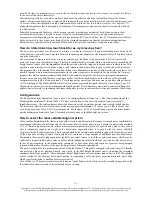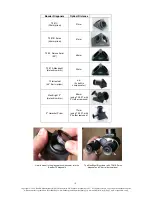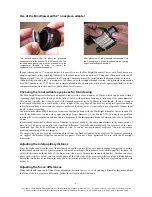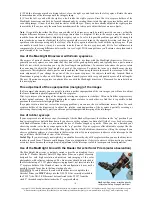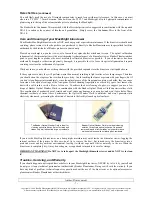
- 2 -
Copyright © 2006, Baader Planetarium GmbH, Unitron Italia Srl, Alpine Astronomical LLC. All rights reserved. Copying or use without express
written consent is prohibited. (Worldwide @ www.baader-planetarium.de),(Italy @ www.unitronitalia.it),(USA @ www.alpineastro.com)
2)
To use the binocular viewer with telescopes such as refractors, Cassegrain reflectors or catadioptrics, a diagonal
prism must be used, inserted between the telescope and the binoviewer. Without the prism it is very uncomfortable
or almost impossible to observe celestial objects high in the sky (i.e. more than 30 degrees over the horizon) with
the binoviewer. But it must be taken into account that the use of a diagonal prism involves an even farther position
of the binoviewer from the telescope, and then increased back focus compensation is needed to reach focus.
Choosing a Glasspath Compensator
The Baader Glasspath Compensator
™
serves multiple functions. In addition to correcting the color error caused by the
long light-path through the binoviewer glass prisms (glasspath), the compensator also magnifies and extends the focal
point of the telescope. This focal extending aspect is key to being able to use a binocular viewer in most telescopes. Due
to the basic design of all binocular viewers, the distance that light must travel through the viewer is on the order of 4.5"
or more (the Maxbright is the shortest viewer we know of, at 110mm). Many telescopes, especially Newtonians, do not
have sufficient back-focus in order to reach focus with such an optically long accessory (ie, not enough focuser in-
travel). By using a Baader compensator, the focal point of the telescope can be extended sufficiently to accommodate
the length of the binoviewer.
A secondary benefit of the compensator is to provide additional magnification - ahead of the binoviewer. For high
magnifications (ie, planetary observation), it is generally preferable to magnify the image before the binoviewer, rather
than to use shorter focal length eyepieces. By magnifying prior to the viewer, the effects of any optical tolerances and
misalignments in the centering of the eyepieces are reduced. A compensator enables the use of longer focal length
eyepieces to achieve high magnifications, which tend to have longer eye relief (greater comfort) than short focal length
eyepieces. It is also less expensive to purchase an additional compensator (to provide additional magnifications), rather
than to purchase additional sets of eyepieces. In general, for binoviewing use we recommend eyepieces with focal
lengths of 8mm or longer.
For these reasons, many users find it is very useful to have more than one compensator. We recommend first choosing
the lowest powered compensator that will allow your scope to reach focus. This will permit the widest possible fields of
view. In addition, one or more higher powered compensators can be added to give a greater range of magnifications.
The first step in choosing a compensator is to determine how much back-focus your telescope has available (please see
the next section on back-focus). Once you have determined the back-focus of your telescope configuration (ie, with any
adapters or star diagonals in place), simply use the following table to determine which compensator (s) provide a path-
length that is less than your telescope's available back-focus.
Please note:
the distances in the following table are
approximate and are measured from the front mounting flange of the binocular viewer or nosepiece, to the top surface
of the eyepiece holders. Many eyepieces have their focal points located ahead of, or behind, their shoulder. As a result,
the effects of an eyepiece's focal point location are not taken into consideration here, as the distance required to reach
focus will usually vary from these values. Users that are near or far-sighted will also find that more or less back-focus is
needed to accommodate their needs. For these reasons, we recommend that you allow for at least 5-10mm extra back-
focus.
For example, our own Takahashi Sky90 SV has 160mm of back-focus as measured from the rear surface of its stock
2"eyepiece clamp to the focal point. From Table 1, you can see that the Sky90 will be able to reach focus without a
glasspath compensator at all, even with our Deluxe Amici correct-image star diagonal. In this case, we would choose
either the 1.7X or 2.6X compensator. This would give us the ability to use the Maxbright with no compensator (for low-
power wide field viewing), and the higher powered compensator provides us with the optimum image quality for higher
magnification planetary observations.
Configuration
None
1.25X
1.7X
2.6X
1.7X
Newtonian
Straight Through (w/ nosepiece only)
110mm
92
77
44
31
with T2 #1C Prism 32 Diagonal
148
131
116
83
na
with T2 #1B Deluxe Zeiss Prism Diagonal
151
134
119
86
na
with T2 #2 Deluxe Amici Diagonal , 90º
(for correct image orientation)
158 141 126 93 na
Table 1: Maxbright Binocular Viewer Path-Lengths
Back-Focus
Sometimes referred to as In-Focus or In-Travel. Back-focus is an important factor to consider when choosing a
binocular viewer, or any other long accessory (cameras, Herschel Wedge, etc). Back-focus is simply the distance from
your telescope's focal point to the surface of its focuser (when fully retracted). Any accessory inserted into the focuser
consumes some of this back-focus (star diagonals, eyepiece adapters or reducers, cameras, eyepieces, etc). In order to
reach focus, the focal plane of an eyepiece (or camera) must be able to be positioned at the telescope's focus. If the
stackup of parts is longer than the telescope's back-focus, then it will not be possible to reach focus. Unfortunately,
telescope manufacturers do not follow any consistent guidelines for the amount of back-focus a telescope should



